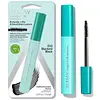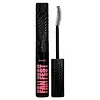What's inside
What's inside
 Key Ingredients
Key Ingredients

 Benefits
Benefits

 Concerns
Concerns

 Ingredients Side-by-side
Ingredients Side-by-side

Water
Skin ConditioningOryza Sativa Bran Wax
Skin ConditioningCyclopentasiloxane
EmollientHydrogenated Olive Oil Stearyl Esters
Emulsion StabilisingAlcohol Denat.
AntimicrobialCopernicia Cerifera Cera
EmollientPalmitic Acid
EmollientStearic Acid
CleansingTriethanolamine
BufferingAcacia Senegal Gum
MaskingCandelilla Cera
EmollientPanthenol
Skin Conditioning1,2-Hexanediol
Skin ConditioningAminomethyl Propanediol
BufferingAscorbyl Palmitate
AntioxidantButylene Glycol
HumectantLaureth-20
EmulsifyingPolyvinyl Alcohol
Vp/Va Copolymer
Chlorphenesin
AntimicrobialPhenoxyethanol
PreservativeCI 77266
Cosmetic ColorantCI 77499
Cosmetic ColorantWater, Oryza Sativa Bran Wax, Cyclopentasiloxane, Hydrogenated Olive Oil Stearyl Esters, Alcohol Denat., Copernicia Cerifera Cera, Palmitic Acid, Stearic Acid, Triethanolamine, Acacia Senegal Gum, Candelilla Cera, Panthenol, 1,2-Hexanediol, Aminomethyl Propanediol, Ascorbyl Palmitate, Butylene Glycol, Laureth-20, Polyvinyl Alcohol, Vp/Va Copolymer, Chlorphenesin, Phenoxyethanol, CI 77266, CI 77499
Water
Skin ConditioningCera Alba
EmollientPolyacrylate-21
Hydrogenated Olive Oil Stearyl Esters
Emulsion StabilisingVp/Eicosene Copolymer
Polybutene
Oryza Sativa Bran Wax
Skin ConditioningStearyl Alcohol
EmollientCopernicia Cerifera Wax
Palmitic Acid
EmollientStearic Acid
CleansingAcacia Senegal Gum
MaskingButylene Glycol
HumectantAminomethyl Propanediol
Buffering1,2-Hexanediol
Skin ConditioningPanthenol
Skin ConditioningCaprylyl Glycol
EmollientChlorphenesin
AntimicrobialHydroxyacetophenone
AntioxidantTrideceth-6 Phosphate
EmulsifyingVaccinium Macrocarpon Seed Oil
Skin ConditioningSodium Dilauramidoglutamide Lysine
HumectantTocopheryl Acetate
AntioxidantDipropylene Glycol
HumectantGlyceryl Caprylate
EmollientHelianthus Annuus Seed Oil
EmollientRosmarinus Officinalis Leaf Extract
AntimicrobialCI 77499
Cosmetic ColorantWater, Cera Alba, Polyacrylate-21, Hydrogenated Olive Oil Stearyl Esters, Vp/Eicosene Copolymer, Polybutene, Oryza Sativa Bran Wax, Stearyl Alcohol, Copernicia Cerifera Wax, Palmitic Acid, Stearic Acid, Acacia Senegal Gum, Butylene Glycol, Aminomethyl Propanediol, 1,2-Hexanediol, Panthenol, Caprylyl Glycol, Chlorphenesin, Hydroxyacetophenone, Trideceth-6 Phosphate, Vaccinium Macrocarpon Seed Oil, Sodium Dilauramidoglutamide Lysine, Tocopheryl Acetate, Dipropylene Glycol, Glyceryl Caprylate, Helianthus Annuus Seed Oil, Rosmarinus Officinalis Leaf Extract, CI 77499
 Reviews
Reviews

Ingredients Explained
These ingredients are found in both products.
Ingredients higher up in an ingredient list are typically present in a larger amount.
1,2-Hexanediol is a synthetic liquid and another multi-functional powerhouse.
It is a:
- Humectant, drawing moisture into the skin
- Emollient, helping to soften skin
- Solvent, dispersing and stabilizing formulas
- Preservative booster, enhancing the antimicrobial activity of other preservatives
Acacia Senegal Gum has skin soothing, thickening, and formulation stabilizing properties. It comes from the Acacia tree that is native to sub-Saharan Africa.
We don't have a description for Aminomethyl Propanediol yet.
Butylene Glycol (or BG) is used within cosmetic products for a few different reasons:
Overall, Butylene Glycol is a safe and well-rounded ingredient that works well with other ingredients.
Though this ingredient works well with most skin types, some people with sensitive skin may experience a reaction such as allergic rashes, closed comedones, or itchiness.
Learn more about Butylene GlycolChlorphenesin is a synthetic preservative. It helps protect a product against bacteria in order to extend shelf life. In most cases, Chlorphenesin is paired with other preservatives such as phenoxyethanol and caprylyl glycol.
Chlorphenesin is a biocide. This means it is able to help fight the microorganisms on our skin. It is also able to fight odor-releasing bacteria.
Chlorphenesin is soluble in both water and glycerin.
Studies show Chlorphenesin is easily absorbed by our skin. You should speak with a skincare professional if you have concerns about using Chlorphenesin.
Learn more about ChlorphenesinCi 77499 is also hydrated iron III oxide. It is created from mixing red and black iron oxides. This helps give shades of darkness to a product.
Iron III oxides are classified as inorganic chemicals for coloring.
Hydrogenated Olive Oil Stearyl Esters is an oil.
Oryza Sativa Bran Wax is wax from the outer layer of a rice kernel. It has moisturizing properties due to its polysaccharides and omega-3 fatty acids content.
This ingredient is a byproduct of milling rice, or the operation to produce a whole grain rice product.
Palmitic Acid is a fatty acid naturally found in our skin and in many plant and animal sources. In cosmetics, it is usually derived from palm oil. It serves many purposes in skincare, acting as a cleanser, emollient, and emulsifier.
As an emollient, palmitic acid helps soften and smooth the skin by preventing water loss. In cleansers, it helps remove oil and dirt while creating foam.
Its emulsifying properties help stabilize products by keeping water and oil-based ingredients from separating.
This may not be suitable for fungal acne-prone skin, as fatty acids like this can sometimes trigger breakouts in sensitive individuals.
Learn more about Palmitic AcidPanthenol is a common ingredient that helps hydrate and soothe the skin. It is found naturally in our skin and hair.
There are two forms of panthenol: D and L.
D-panthenol is also known as dexpanthenol. Most cosmetics use dexpanthenol or a mixture of D and L-panthenol.
Panthenol is famous due to its ability to go deeper into the skin's layers. Using this ingredient has numerous pros (and no cons):
Like hyaluronic acid, panthenol is a humectant. Humectants are able to bind and hold large amounts of water to keep skin hydrated.
This ingredient works well for wound healing. It works by increasing tissue in the wound and helps close open wounds.
Once oxidized, panthenol converts to pantothenic acid. Panthothenic acid is found in all living cells.
This ingredient is also referred to as pro-vitamin B5.
Learn more about PanthenolStearic Acid is a fatty acid. It is an emollient, emulsifier, and texture enhancer.
As an emollient, stearic acid helps soften skin. It aids the skin's protective barrier by preventing water loss. It also provides a gentle cleansing effect without stripping away natural oils.
Stearic acid may also be used to enhance the texture of products. It can add volume and stabilize ingredients such as water and oil. This can help water and oil ingredients from separating.
Sources of stearic acid include animal or vegetable fats/oils such as coconut or shea. It can be naturally found in butter, cocoa butter, shea butter, vegetable fats, and animal tallow.
This ingredient may not be Malassezia folliculitis, or fungal-acne safe.
Learn more about Stearic AcidWater. It's the most common cosmetic ingredient of all. You'll usually see it at the top of ingredient lists, meaning that it makes up the largest part of the product.
So why is it so popular? Water most often acts as a solvent - this means that it helps dissolve other ingredients into the formulation.
You'll also recognize water as that liquid we all need to stay alive. If you see this, drink a glass of water. Stay hydrated!
Learn more about Water